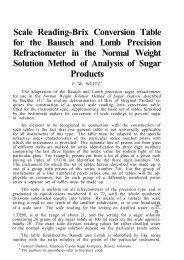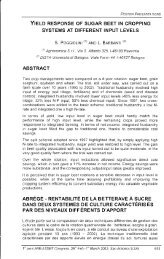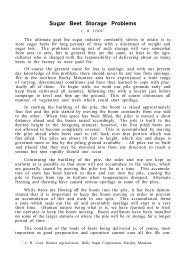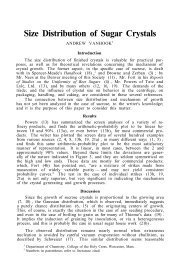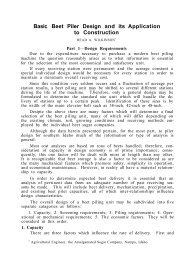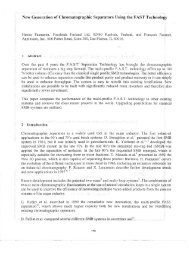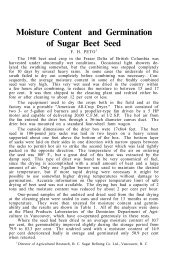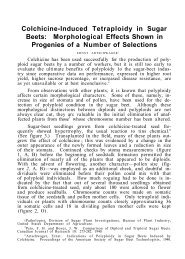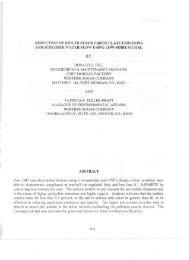Plant-Food Elements in Sugar Beets Throughout the Growing Season
Plant-Food Elements in Sugar Beets Throughout the Growing Season
Plant-Food Elements in Sugar Beets Throughout the Growing Season
Create successful ePaper yourself
Turn your PDF publications into a flip-book with our unique Google optimized e-Paper software.
90 AMERICAN - SOCIETY SUGAR-BEET TECHNOLOGISTS<br />
we undertook an <strong>in</strong>troductory study of this subject for sugar beets.<br />
The publication <strong>in</strong> question dealt only with tomatoes, potatoes, corn<br />
and tobacco, draw<strong>in</strong>g upon experimental data from various American<br />
journals, and experiment station reports.<br />
Object<br />
In this study our object was to ga<strong>in</strong> fur<strong>the</strong>r <strong>in</strong>formation on feed<strong>in</strong>g<br />
sugar beets, from analyses of sugar beets at various stages of<br />
growth. It was an attempt to see what is <strong>in</strong> <strong>the</strong> average sugar-beet<br />
plant at "various stages" <strong>in</strong> order to get some <strong>in</strong>dication of <strong>the</strong> rate<br />
of plant-food absorption dur<strong>in</strong>g <strong>the</strong> grow<strong>in</strong>g season.<br />
Plan<br />
The plan was to utilize sugar-beet plants grow<strong>in</strong>g under normal<br />
Ontario conditions and select random samples whose analyses would<br />
<strong>in</strong>dicate <strong>the</strong> plant-food elements taken <strong>in</strong> by <strong>the</strong> plants up to that<br />
particular stage of growth.<br />
A commercial field <strong>in</strong> each of our factory areas was used and<br />
samples taken at about 3-week <strong>in</strong>tervals. In <strong>the</strong> early stages of<br />
growth a def<strong>in</strong>ite length of row was taken and <strong>the</strong> data calculated<br />
on an acre basis. When <strong>the</strong> beets were of sufficient size, a def<strong>in</strong>ite<br />
number of beets were taken and correlated with average stand and<br />
yield per acre. The data were <strong>the</strong>n calculated back to a l5-tons-peracre<br />
crop.<br />
Roots and tops were weighed and analyzed separately at each<br />
of 7 stages of development. The items <strong>in</strong>vestigated were fresh and<br />
dry weights, nitrogen, phosphoric acid, potash and calcium.<br />
Photographs were taken of <strong>the</strong> beet plants at each of <strong>the</strong> 7 stages<br />
analyzed. and cover <strong>the</strong> normal grow<strong>in</strong>g period of 170 days <strong>in</strong> Ontario.<br />
Methods<br />
Fresh weights were taken of tared beets and tops as soon as<br />
lifted <strong>in</strong> <strong>the</strong> field and dry weights were obta<strong>in</strong>ed after chopp<strong>in</strong>g and<br />
dry<strong>in</strong>g <strong>in</strong> an electric oven at 65º C.<br />
Ash<strong>in</strong>g and preparation of 1 he solution for analysis for P 2 O 5 ,<br />
K 2 O and CaO were made by method of C. F. Rivas, published <strong>in</strong><br />
"Scientific Agriculture," Vol. 19, No. 4, 1938.<br />
Analyses for nitrogen, P 2 O 5 , CaO and K 2 O were made by <strong>the</strong><br />
A. O. A. C. methods, 1940 edition.<br />
Results<br />
The analytical results of <strong>the</strong>se samples, made <strong>in</strong> duplicate, were<br />
averaged for two experimental fields, one a Clyde clay and <strong>the</strong> o<strong>the</strong>r<br />
a Thames clay loam. S<strong>in</strong>ce it was impossible to analyze <strong>the</strong> same<br />
beets throughout <strong>the</strong> grow<strong>in</strong>g season, <strong>the</strong>re is considerable variation<br />
<strong>in</strong> <strong>the</strong> contents found. The stages of growth, however, were dist<strong>in</strong>ct<br />
and show <strong>the</strong> relative composition of <strong>the</strong> sugar beets at approximately<br />
3-week <strong>in</strong>tervals.





